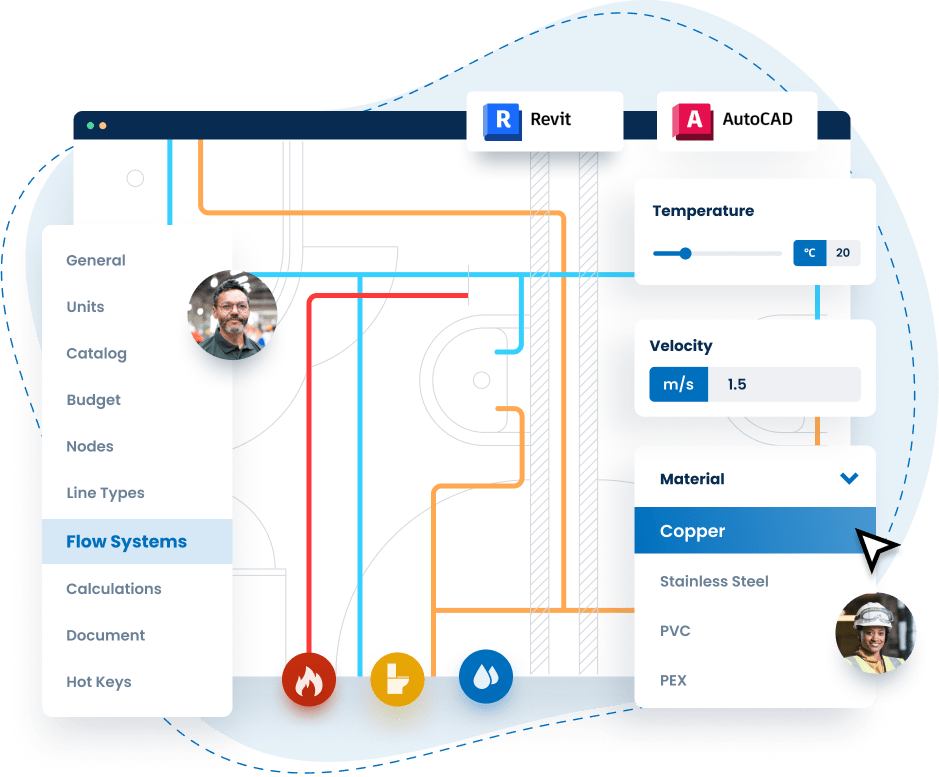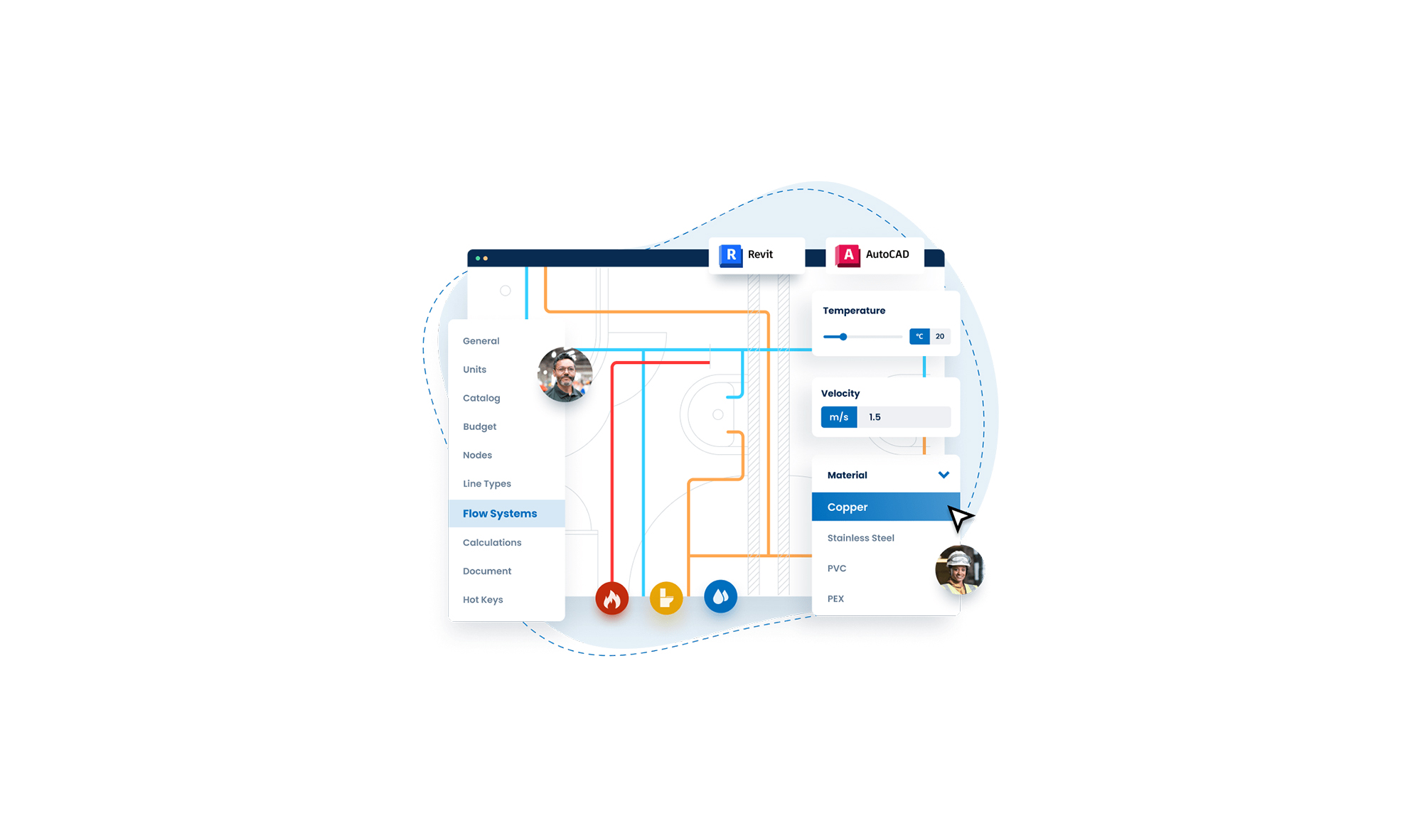Founded in 2019 by a team of mechanical and software engineering experts, h2x set out to address the limitations of traditional processes and tools within the industry. The company provides cutting-edge, user-friendly, highly efficient design and calculation software for professionals in the mechanical, fire, and plumbing sectors.
By simply drawing a system on a PDF, h2x performs all necessary calculations, is verified by CIBSE, and offers a variety of export options, including:
- AutoCAD;
- Revit;
- Bill of Materials;
- Calculation Spreadsheet;
- Design Report;
- PDF.
Their mission is to boost efficiency, minimise errors, and streamline workflows for engineers and contractors worldwide.
Interview with Jonathan Mousdell, Director of h2x.
Easy Engineering: What are the main areas of activity of the company?
Jonathan Mousdell: h2x primarily focuses on two key areas of activity:
Knowledge sharing:
Our “Knowledge Centre” is a complimentary online resource hub where industry professionals can access calculators, webinars, technical blogs, and more to hone their technical skills.
The platform features step-by-step guides on designing and calculating, along with helpful tips for upcoming projects.

Design software:
Our design software is known for its exceptional efficiency and accuracy, providing engineers with a powerful tool to create more effective and sustainable systems.
Used by teams of various sizes globally, the software plays an integral role in engineering projects ranging from residential homes to multi-billion dollar developments.
E.E: What’s the news about new products?
J.M: We release software updates each weekend, meaning our users have a better product every time they log in on a Monday morning.
Customer feedback is invaluable, and we prioritise implementing their suggestions, which range from minor usability enhancements to major calculation features.
In the coming months, we have several exciting new product developments in the pipeline:
- Mechanical Ventilation with Heat Recovery (MVHR) to complete our HVAC offerings
- Revit Two-Way Sync for seamless links between h2x’s calculations and the Revit design
- Comprehensive fire services calculations for fire hydrants, hose reels, and sprinklers
- Automatically generated schematic diagrams
E.E: What are the ranges of products?
J.M: Our product range caters to:
- Engineers
- Modellers/drafters
- Contractors
- Estimators
- Manufacturers
Who work with the following systems:
- Mechanical
- Heating
- Chilled
- Ventilation
- Plumbing
- Water
- Gas
- Wastewater
- Stormwater
- Fire
- Fire hydrants
- Fire sprinklers
- Fire hose reels
E.E: At what stage is the market where you are currently active?
J.M: As building complexity increases, so does the demand for automation and optimisation in MEP systems.
Clients require high-quality, long-lasting solutions with precise and accurate calculations, especially for emerging sustainable technologies like heat pumps.
Additionally, the growing adoption of Building Information Modeling (BIM) in the industry further underscores the need for enhanced efficiency and quality.
E.E: What can you tell us about market trends?
J.M: Notable market trends include:
- Rising use of heat pumps and Mechanical Ventilation with Heat Recovery (MVHR) systems
- Increasing adoption of BIM in the design process
- The necessity for iterative design processes to evaluate various options, typically related to energy efficiency, sustainable solutions, and prefabrication of typical components
- More condensed timelines for designing, tendering, and installing

Other construction disciplines (e.g., structural, architectural) already employ tools to assist with their workflows, and our goal is to help the MEP industry catch up.
E.E: What are the most innovative products marketed?
J.M: Our flagship product is a comprehensive, single software solution that combines a straightforward user interface with powerful design capabilities and accurate calculations.
Its extensive range of exports and integrations promotes seamless collaboration and communication among various stakeholders throughout the design process.
E.E: What estimations do you have for 2023?
J.M: As we progress through 2023 and beyond, we expect the following developments in the industry:
- A heightened focus on sustainable, energy-efficient building designs
- Increased importance placed on indoor air quality
- The development of ‘smarter’ buildings featuring data tracking, touch-free systems, and adaptable spaces
- Greater emphasis on creating “digital twins” of buildings before actual construction to improve timelines and identify potential risks
- A competitive edge for contractors offering innovative prefabrication solutions
- Workforce challenges due to shortages in specialised engineering and labour fields
- Rising adoption of software solutions (BIM) to enhance efficiency across various phases of construction projects through automation and optimisation

